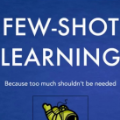This paper studies few-shot learning via representation learning, where one uses $T$ source tasks with $n_1$ data per task to learn a representation in order to reduce the sample complexity of a target task for which there is only $n_2 (\ll n_1)$ data. Specifically, we focus on the setting where there exists a good \emph{common representation} between source and target, and our goal is to understand how much of a sample size reduction is possible. First, we study the setting where this common representation is low-dimensional and provide a fast rate of $O\left(\frac{\mathcal{C}\left(\Phi\right)}{n_1T} + \frac{k}{n_2}\right)$; here, $\Phi$ is the representation function class, $\mathcal{C}\left(\Phi\right)$ is its complexity measure, and $k$ is the dimension of the representation. When specialized to linear representation functions, this rate becomes $O\left(\frac{dk}{n_1T} + \frac{k}{n_2}\right)$ where $d (\gg k)$ is the ambient input dimension, which is a substantial improvement over the rate without using representation learning, i.e. over the rate of $O\left(\frac{d}{n_2}\right)$. This result bypasses the $\Omega(\frac{1}{T})$ barrier under the i.i.d. task assumption, and can capture the desired property that all $n_1T$ samples from source tasks can be \emph{pooled} together for representation learning. Next, we consider the setting where the common representation may be high-dimensional but is capacity-constrained (say in norm); here, we again demonstrate the advantage of representation learning in both high-dimensional linear regression and neural network learning. Our results demonstrate representation learning can fully utilize all $n_1T$ samples from source tasks.
翻译:本文通过演示文稿学习少片 学习 通过演示文稿学习, 其中一个人使用$T$ 源任务, 每任务用$1美元 来学习演示文稿, 以便减少目标任务中只有$_ 2 (ll n_ 1) 数据的样本复杂性 。 具体地说, 我们侧重于在源和目标之间存在良好的 emph{ 共度代表的设置, 我们的目标是 了解样本规模的削减有多大是可能的 。 首先, 我们研究这个共同的演示文稿是低维的设置, 提供 $left (\ maxxxxxxxxxxxxxxxxxxxxxxxxxxxxxxxxxxxxxxxxxxxxxxxxxxxxxxxxxxxxxxxxxxxxxxxxxxxxxxxxxxxxxxxxxxxxxxxxxxxxxxxxxxxxxxxxxxxxxxxxxxxxxxxxxxxxxxxxxxxxxxxxxxxxxxxxxxxxxxxxxxxxxxxxxxxxxxxxxxxxxxxxxxxxxxxxxxxxxxxxxxxxxxxxxxxxxxxxxxxxxxxxxxxxxxxxxxxxxxxxxxxxxxxxxxxxxxxxxxxxxxxxxxxxxxxxxxxxxxxxxxxxxxxxxxxxxxxxxxxxxxxxxxxxxxxxxxxxxxxxxxxxxxxxxxxxxxxxxxxxxxxxxxxxxxxxxxxxxxxxxxxxxxxxxxxxxxxxxxxx




